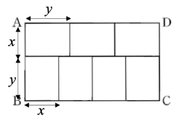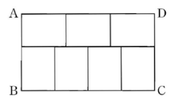=>
We can put unknown variables x and y in the following figure.

We have 4x = 3y or y = (4/3)x and 7xy = 336 or xy = 48.
Substituting y = (4/3)x into xy = 48 gives us x(4/3)x = 48, 4x^2/3 = 48, x^2 = 36, and x = 6.
Then xy = 48 becomes 6y = 48 and y = 8.
We have x = 6 and y = 8.
So, the perimeter is 2(x + y + 4x) = 10x + 2y = 10*6 + 2*8 = 60 + 16 = 76.
Therefore, C is the answer.
Answer: C




